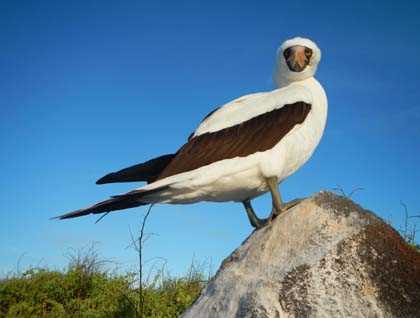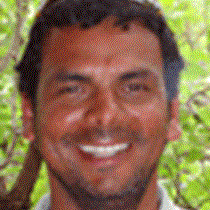Today in the morning we started the adventure on the island of Espanola, the most southeasterly island in the archipelago and no doubt one of two oldest islands in this group of oceanic islands so remote in the Pacific Ocean. The National Geographic Islander was anchored in front of Gardner Bay where the early morning explorers were ready for the first adventure of the day, kayaking. It appeared to be overcast but what we look for along the coast of Espanola was waiting for us so we didn’t waste time. Soon after we headed out the sea lions were playing behind the bow of the kayaks, and not too far away the Pacific green sea turtles were popping up their heads and, like a symphony, we heard their deep exhaling, which made us so excited we did not know where to look. What a nice way to begin today.
By 7:30 we were back on board for breakfast for our schedule holds many more activities. After breakfast the next outing was deep water snorkeling; for this we decided the best stop is Gardner Islet, a little rock standing close to the coast of the island of Espanola. Over there we had a group of sea lions ready to play with the aquatic explorers, and we had a chance to see the pretty colors of the reef fish swimming nearby. The great topography underwater, such as sea stars and sea urchins decorating the bottom of the ocean, made this adventure a magnificent stop.
After the deep water snorkeling we made a quick stop at the National Geographic Islander to get rid of the snorkeling gear and set course to the beach of the bay, embracing the endless number of sea lions lying on the beach sun basking. The place looks so great with so many birds, so many colors, and everything so peaceful. Afterwards we were ready to go back to the ship and rest after a delicious lunch for the second part of our expedition today.
In the afternoon all explorers were lined up by the reception area for a dry landing at Punta Suarez; the tide was high and we needed to change the landing site to a rocky area instead, but it wasn’t much of a problem. On the path the sea lions got the attention of the adventurers and there were so many birds it was hard to count.
We decided to take the path driving us directly to where the waved albatross were nesting and the first impression was of how big they are. Most of them were incubating an egg, but some were dancing and others walking with what looked like a clumsy dance. Of course we stopped and talked about all we know about them, and then walked the scenery and the cliff area.
After two hours and thirty minutes’ walk we all felt grateful for this fantastic natural experience in this beautiful place. All explorers on board were highly excited about what is next, but how are the Galápagos Islands going to top what we have seen today?







